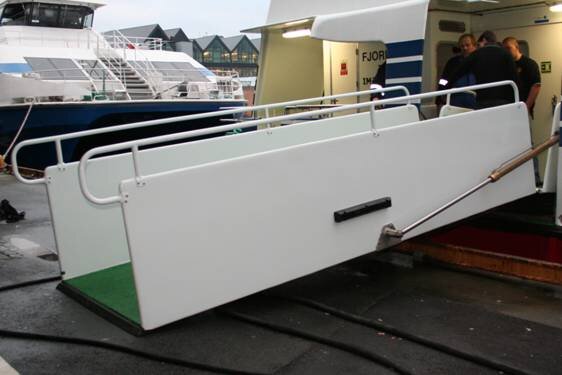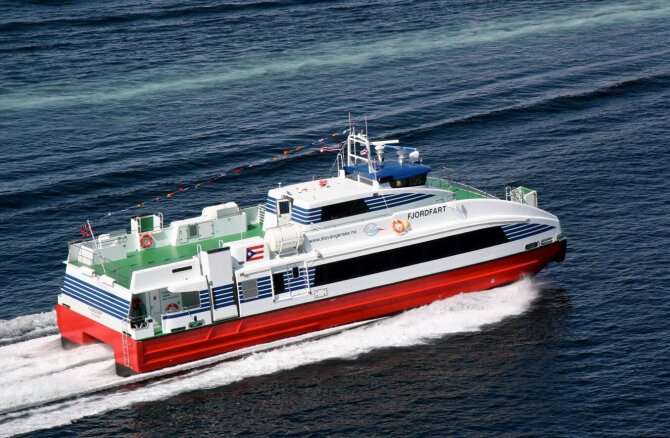High-speed passenger ferries in Rogaland
There was great excitement in Rogaland when a new call for tender went out for high-speed passenger ferries in Ryfylke in 2009. One of the key criteria was that the ferries should be universally designed. However, there were no national or international recommendations for ships carrying less than 400 passengers, so specifications had to be worked out on the job. This was a detailed, comprehensive project that lay the groundwork for the design of the popular catamaran we see today.
The high speed passenger ferries in Rogaland set a norm for universally designed maritime passenger transportation in Norway and other countries, and elements from the first ferries were later incorporated as standard.
Project owner: Tide Sjø (now Norled)
Client: Rogaland Kollektivtrafikk FKF, Kolumbus
Design and construction: Brødrene Aa
Lead users:
Norwegian Association for the Blind and Partially Sighted and the Norwegian Association for the Disabled
Methods:
Interviews, consulting
Awards:
Winner of the Innovation Award for Universal Design 2011 in the category Transport.
50%
reduction of docking time with an adjustable gangway
CHALLENGE
With no regulations on universal design for this type of passenger ferries Tide Sjø, their client Rogaland Kollektivtrafikk FKF, Kolumbus and the shipyard Brødrene Aa in Hyen decided to design the best transport for ALL together, setting a standard for the future. How did they go about it?

APPROACH
Tide Sjø set out to establish a good level of cooperation with the ship designers Brødrene Aa in Hyen and their client Rogaland Kollektivtrafikk FKF, Kolumbus early on. They saw the importance of working closely with the shipyard already during the contracting phase. They held meetings with both the yard and representatives from the client to discuss universal design and ensure that they were all on the same wavelength.
Listening and learning from diversity was a mantra from the start. Kolumbus prepared the design specifications and ensured that organisations such as the Norwegian Association for the Blind and Partially Sighted and the Norwegian Association for the Disabled, who represented different user groups, were consulted. The existing regulations were too general in their nature, and compromises often had to be made. Each compromise was individually considered and the resulting solutions always aimed to make things better than before.
When we all have the same focus on the work to be done and the same shared goals, then all aspects of the process are made easier. And even though universal design can present challenges, it does not cost any more. It is all about getting the design right the first time. The most successful universal measures are those that no-one sees. Those are the solutions which are truly inclusive for all.

RESULT
The high-speed passenger ferries in use has been very successful. Passengers find everything on board intuitive and very few encounters difficulties. Embarkation and disembarkation is done efficiently, saving time for everyone.
The gangways have been redesigned so that a wide range of people can get on and off without assistance. They can be adjusted hydraulically allowing the crew to change the length, height and angle of inclination. They also have non-slip surfaces and no steps, and the handrails are positioned at two heights along the entire length for added usability. The gangways ensure easy access to the ship for wheelchair users and parents with strollers, and also for service trolleys. Enabling all passengers to board and embark the ferry by themselves frees time for the crew and make time for faster transport between stops.
Inside the ferries, colours, patterns and flooring have been selected to make it easier for visually impaired passengers to orient themselves. Lighting points are strategically positioned to create natural ambience and atmosphere, and also to provide dedicated task lighting. Signage and plans throughout the ship are tactile and provided in 3D for people who navigate using touch.
The ferries have induction coils, so all information given on the loudspeaker system can be heard by passengers using hearing devices. All safety information is also shown on monitors around the ship to reinforce the message and the ferry’s position is shown in real time on the monitors in the passenger salon. Prior to docking the name of the port is displayed on the monitors which also makes it easier for passengers who do not speak Norwegian. The ferries are also equipped with external electronic destination signage. And last but not least, all construction materials and textiles were selected with regard for people with allergies or hypersensitivity.
The high-speed passenger ferries in Rogaland set an early norm for universally designed maritime passenger transportation in Norway and other countries and elements from the first ships were early on incorporated as standard. The main features are designing so that passengers can travel independently. Everything is located on one deck without stairs or thresholds. Gangway and hydraulically adjustable landing gear simplify embarking and disembarking for all users, while increasing safety and saving time. Tactile signs ensure that visually impaired easier can orient themselves well on board. Inductive loop make the information over the speakers available to passengers with a hearing aid. The ferry’s position, departure and port are displayed on monitors. Allergy-friendly building materials and textiles have been used along with reflex-free paint and grab handles along the walls and seats. There is plenty of room for wheelchairs and strollers, and they can all be secured to the floor. The kiosk has disks at various heights and the toilets have extra large rooms. With these design details the Rogaland Public Transport FKF definitely fulfilled it’s motto:
"A means of transport for ALL"
All these criteria became a standard for ships by Brødrene Aa. They built on their experience from this pioneering project and have made universal design a clear objective for their new designs. They have won several awards on universal design for Vision of the Fjords both in Norway and abroad with their customer the Fjords.

The most common argument against universal design is that it is expensive. But this is not the case. If such considerations are not taken at the earliest stages of a build, then you face expensive alterations at a later date. And the costs soon rise. These costs can be avoided if universal design is considered right from the start. At the same time, an inclusive solution will almost certainly give a competitive edge, expand the customer base and make the customers more satisfied, thereby increasing market share and improving results. The customer of tomorrow will demand universal design. This means that public and private companies will increasingly seek such services.